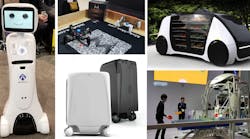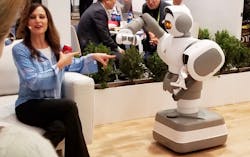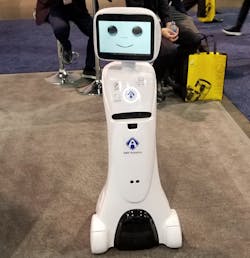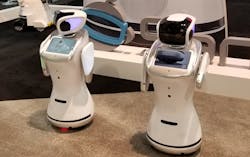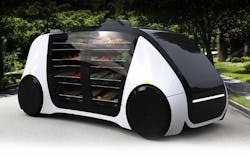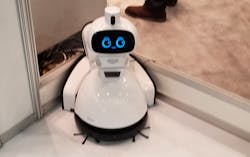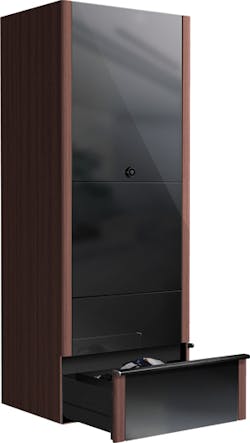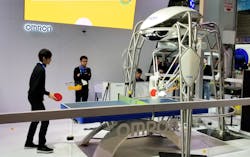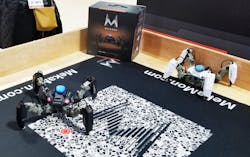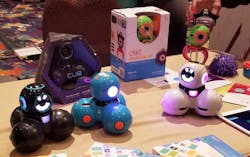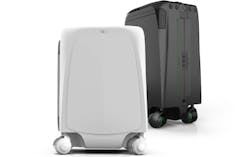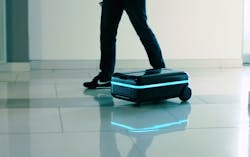Robots were literally everywhere at this year’s Consumer Electronics Show (CES). They were handing out collateral, entertaining the masses, and sometimes performing tasks like folding clothes, or playing ping pong.
1. Aeolus Robotics’s Aeolus Robot has arms with seven degrees of freedom.
For instance, Aeolus Robotics’s Aeolus Robot (Fig. 1) has interchangeable arms with seven degrees of freedom (7 DOF), which allows it to do chores such as vacuuming and putting away dishes. The voice-controlled robot is also integrated with voice-command systems like Amazon Alexa and Google Home. And by leveraging artificial intelligence (AI), the robot will recognize such things as a person’s change in posture, which might occur if someone might be falling.
2. The Segway Loomo is an advanced personal robot.
Segway’s Loomo (Fig. 2) is an advanced person robot. Developers can take advantage of its Intel RealSense 3D camera. It adds Simultaneous Localization and Mapping (SLAM) capability to the same type of two-wheeled personal transporter platform used for moving people. The software development kit supports Android.
3. Amy Robotics’ A1 is an intelligent assistant that can be used as a telepresence robot.
The A1 robot (Fig. 3) from Amy Robotics is an intelligent assistant. It can be used as a telepresence robot, providing mobile video conferencing. The AI support includes autonomous navigation support and can follow people. It uses a combination of 3D cameras and ultrasonic sensors to locate obstacles.
4. Controllable with a smartphone app, the Qihan Sanbot Elf is a robot development platform.
The Qihan Sanbot Elf (Fig. 4) is an open API robot development platform. It’s integrated with the Qihan Cloud and can be controlled using a smartphone app. Automatic obstacle avoidance and navigation takes advantage of a range of sensors, such as a 3D camera, PIR human body thermal inductance, and IR perception. It has touch perception in addition to a touchscreen. The Sanbot family has a range of platforms, including the tiny Sanbot Nano and the two-armed Sanbot Max.
Delivery Robots
There were a number of delivery robots at CES. Some were rolling boxes designed to deliver packages or other items.
5. Robomarts is designed to automatically deliver a selection of food.
Robomarts’s robot (Fig. 5) is a self-driving car designed to deliver fruits and vegetables. It’s a grocery store on wheels. Fresh produce makes up around 60% of all groceries sold, but, according to Kantar Worldpanel, just a small fraction is ordered online because consumers want to see what they’re buying. The company plans to deploy a fleet of delivery robots to let consumers order and pick their produce.
The electric vehicle will arrive on demand. Consumers take what they like and are charged accordingly.
Home Robots
6. EQL Qubi adds a robotic torso to a vacuum-cleaning robot.
CES has plenty of robots that target the home, including the usual collection of robotic vacuum cleaners. Some, like EQL Technology’s Qubi, has its own take on a vacuum-cleaning robot (Fig. 6). Its torso is detachable and adds face and speech recognition to an otherwise conventional vacuum robot. This top allows the system to be used as a security robot.
7. Panasonic created the laundry-folding Laundroid along with Seven Dreamers Laboratories.
Panasonic developed Laundroid (Fig. 7) in conjunction with Seven Dreamers Laboratories. The robot is hidden inside an armoire. The bottom drawer is where a user drops unfolded, clean laundry fresh from the dryer. The robot detects the type of each garment, folds it, and places it in the appropriate shelf. Check out the video:
Fun Robots
It was not all robotic business at CES. There was plenty of fun to be had, too.
Omron is known for its industrial robots. Its ping-pong playing robot called Forpheus (Fig. 8) included a number of industrial robots. The system is designed to be a ping-pong tutor. It’s not meant to beat a human player, but rather keep the rally going so that the player can improve. Its uses a combination of AI and cameras to track the ping-pong ball and return it.
8. Omron used a combination of industrial robots to build a system that could help train ping-pong players.
MekaMon created a fast, four-legged robot designed for gaming (Fig. 9). It works with an augmented-reality (AR) smartphone application for Mek versus Mek battles. The AR support also lets a single Mek compete with virtual partners.
9. MekaMon’s four-legged robot is designed to be a fast, gaming robot.
Wonder Workshop’s Cue (Fig. 10) is part of the company’s Cleverbot family. It has three proximity sensors and an emotive AI system to allow interaction with users. Four avatars bring charm and style to this interaction. It can be programmed using a graphical block language or Javascript, depending on the user’s skill level. This is an educational robot that can grow with the user.
10. Wonder Workshop’s Cue Cleverbot uses an emotive AI system to interact with users.
Smart Suitcases
A number of smart suitcases were on display at CES. Forwardx’s CX-1 (Fig. 11) was the typical companion following robot. The CX-1 has a 170-deg., wide-angle camera and laser radar for object identification and SLAM support. The camera is also used to recognize control gestures. The four-wheel drive system is designed to handle rough terrain including dirt roads. A user wrist band provides a proximity alarm system. Its battery can double as a power bank for recharging smartphones.
11. Forwardx’s CX-1 is a companion following suitcase. Rugged wheels allow it to operate on a wide range of surfaces.
Travelmate Robotics’ Travelmate smart suitcase includes a removable GPS system (Fig. 12). The robot lays flat, allowing objects to be placed on top; it can also follow vertically. It integrates with the user’s smartphone. Like most smart suitcases, it can follow the user, avoiding obstacles. The suitcase comes in three versions: small, medium and large.
12. Travelmate Robotics’s Travelmate smart suitcase has GPS. Its battery can be used to charge devices like smartphones.
